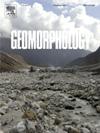Flow dynamics and bed morphology in a narrow channels: A comparative study of experimental and numerical approaches to velocity distribution
IF 3.1
2区 地球科学
Q2 GEOGRAPHY, PHYSICAL
引用次数: 0
Abstract
The effects of narrow channels on flow structure and hydrodynamics have been widely studied. However, due to the complexity of flow dynamics in narrow channels, three-dimensional flow properties have rarely been explored. This paper presents a novel experiment investigating the influence of narrow channels with an aspect ratio of 4.615 on three-dimensional turbulent properties and bed morphology. The findings contribute to a deeper understanding of how narrow channels impact turbulent properties and bed feature dynamics in mobile bed flows. The results showed that longitudinal velocity is higher towards the centre and free surface, while vertical velocity shows upward flow near the bed and downward flow towards the free water surface, with intensities varying across the channel. Experimental longitudinal velocity was compared numerically using the Realizable k-ε model by Ansys Fluent software and an analytical model. Both models performed well in predicting values, with the analytical model showing slightly higher accuracy as indicated by statistical indices. Turbulent kinetic energy and Reynolds shear stress are higher close to the bed and banks of the channel. Bed features generates ripple bedforms, which are dynamic and complex, influenced by flow dynamics, sediment transport, and channel geometry, creating a rich and intricate flow environment. The three dimensional skewness and kurtosis are also explored in this paper. This information is valuable for river or canal design engineers, with implications for stability and navigation, and it can guide maintenance strategies for narrow rivers and canals.
求助全文
约1分钟内获得全文
求助全文
来源期刊

Geomorphology
地学-地球科学综合
CiteScore
8.00
自引率
10.30%
发文量
309
审稿时长
3.4 months
期刊介绍:
Our journal''s scope includes geomorphic themes of: tectonics and regional structure; glacial processes and landforms; fluvial sequences, Quaternary environmental change and dating; fluvial processes and landforms; mass movement, slopes and periglacial processes; hillslopes and soil erosion; weathering, karst and soils; aeolian processes and landforms, coastal dunes and arid environments; coastal and marine processes, estuaries and lakes; modelling, theoretical and quantitative geomorphology; DEM, GIS and remote sensing methods and applications; hazards, applied and planetary geomorphology; and volcanics.
 求助内容:
求助内容: 应助结果提醒方式:
应助结果提醒方式:


